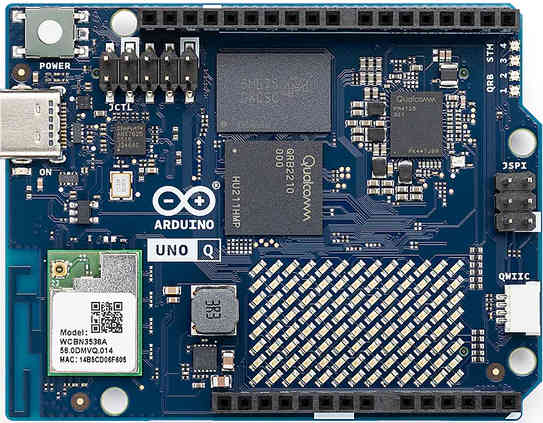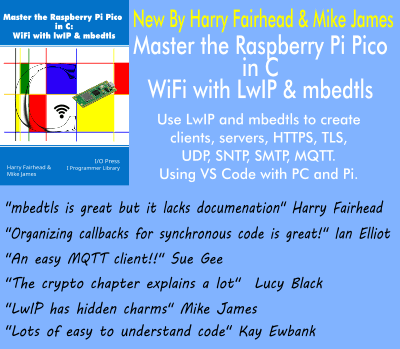| Arduino UNO Q Takes On Raspberry Pi |
| Written by Harry Fairhead | |||
| Wednesday, 08 October 2025 | |||
|
Arduino has just been taken over by Qualcomm, a company generally known for its many patent disputes as well as its ARM processors. More importantly, a new Arduino has just been announced that could be a big competitor to Raspberry Pi. Arduino has generally produced small controller type boards that operate in the same market as the Raspberry Pi Pico. Despite the size of its offerings increasing every year, so far it has produced nothing that could compete with the Linux-running Raspberry Pi, until now.
The new UNO Q is capable of running a standard Debian Linux. Its processor line up is clearly influenced by Qualcomm:
The Pi 5 has a similar arrangement. It uses a cut-down Pico acting as the real-time component, but there is very little end-user information on it and no easy way to program it. At least with this hardware we know that the microcontroller is running Zephyr OS and there is a documented RPC, so you can call code from the main processor. The main processor runs a standard Debian Linux, unlike Pi OS which is a modified Debian, and shouldn't need any additional support from Arduino.
It has all of the I/O you would expect - 6 ADC, 2 DAC, 6 PWM, 2 UART, 3 SPI, 4 I2C and more.You can get at all of the GPIO lines via the standard Arduino interconnect and it takes Arduino expansion cards. Unusually, there is also an 8x13 RGB LED array, you can see it at the bottom right, that you can use for very simple communication with the outside world and there are two independent RGB LEDs to flash. Of course, there is a radio module supporting WiFi 4 with both 2.4 and 5GHz and it supports Bluetooth 5.1. The really novel part is that there is just a single USB C connector. This supplies power and lets you communicate with the device using a host machine. If you want standalone then you will need a USB C hub that supports power and HDMI, USB, Flash, Ethernet and whatever else you need. Of course, the cost of a hub is going to increase the total cost by about $20 for a finished unit, but it still very competitive with the Pi 5 at $44 for the 2G version and there will be a 4G version in the near future. Comparing it to a Pi 5 reveals that the Pi 5 has more RAM, a slightly faster clock speed and more built-in interfaces and is slightly more expensive for a 2GB version. Which one you prefer all comes down to software support and on that front the Arduino has the edge. The announcement makes a big thing of using the device with AI and Qualcomm has the ability to make this work. However, it is still an interesting and attractive alternative to the Pi even without the promise of AI. In addition we have more software support in the form of App Lab:
This is another huge advantage for the ambitious beginner with an idea that is currently beyond their technical expertise. You can also use the traditional Arduino IDE and that is good enough for most programmers. Arduino has always invested more in its software than Raspberry Pi, which doesn't do much to ensure that its hardware is well-supported. (Most Pi software starts out with enthusiasts making the effort, only to be taken over a bit later by an official Pi version). Is the UNO Q going to be successful? There have been lots of "better Pis" on the market, but mostly they haven't been able to match the software-support of the real Raspberry Pi or to assure longevity. If this was a board produced by any company other than Arduino then I don't think I'd be taking it as seriously. Arduino has good software support and is slightly more open source than Raspberry Pi. Exactly how all of this will pan out is going to be interesting to watch. Qualcomm says that it doesn't plan to interfere with the way Arduino operates and as long as it is true to its word I can see the UNO Q making deep in roads into the Pi's territory. Given access to Qualcomm's hardware, the future also looks bright for follow-on models. Of course, all of this is conditional on the real hardware, and the software in particular, being as good as the press release claims. Take a look at the video to see for yourself: More InformationRelated ArticlesProgramming The ESP32 Using Arduino - PWM Arduino IDE 1.8.11 - The State Of The Arduinosphere Arduino Back To Being One Company Arduino Zero Pro Released Amid Legal Dispute Arduino Goes Official - Release of 1.0 To be informed about new articles on I Programmer, sign up for our weekly newsletter, subscribe to the RSS feed and follow us on Twitter, Facebook or Linkedin.
Comments
or email your comment to: comments@i-programmer.info
|
|||
| Last Updated ( Wednesday, 08 October 2025 ) |


